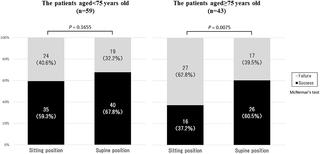PLOS ONE ( IF 2.9 ) Pub Date : 2018-09-20 , DOI: 10.1371/journal.pone.0204363 Tomoko Naito , Keiji Yoshikawa , Koji Namiguchi , Shiro Mizoue , Atsushi Shiraishi , Yuko Ichikawa , Miyuki Fujiwara , Takako Miki , Ryoichi Araki , Yuzo Umeda , Yuki Morizane , Fumio Shiraga

|
Purpose
To compare the success rates of eye drop instillation in the sitting position and supine position among Japanese patients with ocular diseases (cataract, glaucoma, or retinal and vitreous diseases).
Methods
Patients who were hospitalized in Okayama University Hospital for eye surgery were studied. Instillation procedures of each patient in both the sitting and supine positions were recorded using a video camera at the time of instillation. We defined “success” when one drop fell accurately onto the ocular surface at the first attempt. Instillation of two or more drops, drops delivered to a site other than the eye surface, and touching the eyelashes, eyelids, or conjunctiva with the tip of the eye drop bottle were regarded as “failure”. We excluded patients with vision below counting finger.
Results
One-hundred and two patients (54 males and 58 females, aged 70.2 ± 12.3 years) with ocular disease who were hospitalized for surgery (cataract: 61.8%, glaucoma: 15.7%, retinal and vitreous diseases: 22.5%) were included in this prospective observational study. The mean duration of eye drop use was 3.1 ± 5.2 years. The success rate of eye drop instillation was significantly higher in the supine position than in the sitting position (64.7% vs. 50%, P = 0.0039). The mean age was significantly higher in the failure group than in the success group (74.0 ± 11.5 vs. 67.7 ± 12.4 years, P = 0.0085) for the sitting position, but not significantly different for the supine position (72.3 ± 12.9 vs. 70.1 ± 12.0 years, P = 0.3849). No significant differences in mean duration of drop use, mean corrected VA, and mean spherical equivalent refraction were observed between success and failure groups, for both sitting and supine positions.
Conclusions
In the present study, the success rate of eye drop instillation was significantly higher when applied in the supine position than in the sitting position.
中文翻译:

坐姿和仰卧位滴眼液滴注成功率的比较
目的
比较日本眼科疾病(白内障,青光眼或视网膜和玻璃体疾病)患者坐姿和仰卧位滴眼液的成功率。
方法
研究了在冈山大学医院眼外科住院的患者。在滴注时,使用摄像机记录每个患者在坐位和仰卧位的滴注程序。我们定义“成功”是指在第一次尝试中一滴准确落在眼表上时。滴入两滴或更多滴,滴到眼睛表面以外的地方,并用滴眼液瓶的尖端接触睫毛,眼睑或结膜,均被视为“失败”。我们排除了视力低于手指数的患者。
结果
包括住院治疗的眼科疾病的一百零二例患者(男54例,女58例,年龄70.2±12.3岁)(白内障:61.8%,青光眼:15.7%,视网膜和玻璃体疾病:22.5%)。前瞻性观察研究。滴眼剂的平均使用时间为3.1±5.2年。仰卧位滴眼的成功率显着高于坐位(64.7%vs. 50%,P = 0.0039)。坐位的平均年龄显着高于成功组(74.0±11.5 vs. 67.7±12.4岁,P = 0.0085),但仰卧位则无显着差异(72.3±12.9 vs. 70.1)。 ±12.0年,P= 0.3849)。对于坐位和仰卧位,成功组和失败组之间的平均跌落时间,平均矫正视力和平均等效球镜屈光度均无显着差异。
结论
在本研究中,仰卧位滴眼滴注的成功率显着高于坐位。











































 京公网安备 11010802027423号
京公网安备 11010802027423号